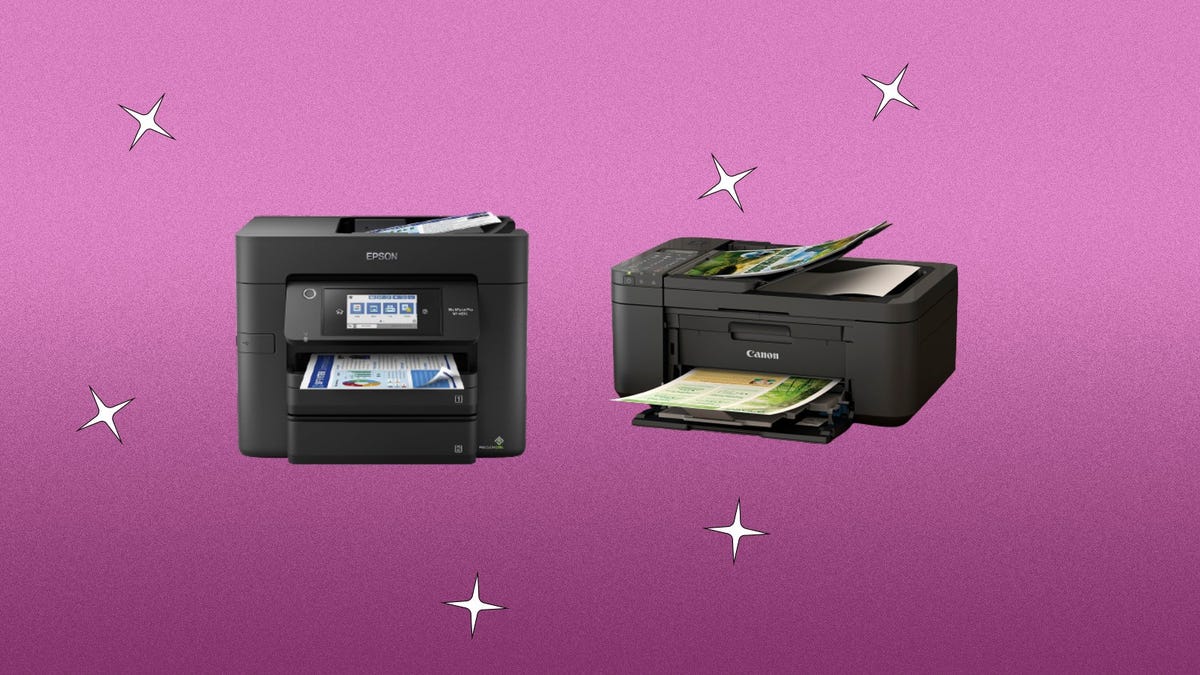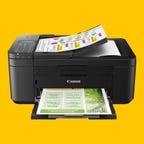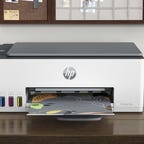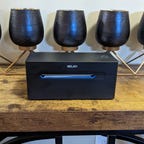Best Printer for 2023

HP OfficeJet Pro 9015e
Complete office solution

Canon Pixma TR4720
Average all across the board, except the price

HP Smart Tank 5101
A great midrange printer with a lot of ink

Nelko Bluetooth Thermal Shipping Label Printer
Made for purpose printer
Sawgrass SG500 Sublimation printer
Make your art come alive
Expression Home 4100
An excellent balance of cost and performance
With tons of people now working from home, we’ve seen a renaissance for home printers. If you’re one of the many folks who find themselves in need of their own printer, CNET is here to help you find the right one. We’ve combed through the changing landscape of printers to bring you the best models available in 2023, so you can print photos, documents, college essays and more whenever you need to.
Every printer profiled below can manage basic printing needs. For example, they can handle mobile printing and wireless printing from a phone or any PC, Mac or Chromebook, which is a must when it comes to office printers. They can also print over a cabled connection and via wireless printer connectivity. (Note that some — but not all — printers support Apple’s AirPrint and Google’s Cloud Print protocols, which are usually less onerous than the printer vendors’ proprietary systems.)
But what you intend to print will determine which is the best printer for you. If you’re mostly working with shopping lists, concert tickets or travel itineraries, having excellent print quality is arguably less important than print speed and price. If you’re using your printer for professional materials or photo printing, then color accuracy, printing quality and the inclusion of features like borderless printing will be primary considerations when you’re looking for the right printer.
Another factor to consider is the cost of ink and ensuring you have enough ink to print everything you need. (There’s nothing more frustrating than having a printer but no ink in the ink tank.) Inkjet printers use liquid ink to print, whereas laser printers use toner cartridges containing powder. So even if you’re getting a great printer deal, just be sure to do some research into how you’ll refill the ink, so you can choose the best printer for your overall budget. Some new printers include an ink subscription in their original price tag, so that may be something to consider as well.
We’ve tested and reviewed the top models for home and small office use from many of the major printer manufacturers including Brother, Canon, Epson and HP. Whether you print for business or personal use, we’ve got the best printer for you.
If you work from home but need all the advantages of an office printer, the OfficeJet Pro is an excellent choice. In terms of sheer printing speed, the HP is ahead of most others in its price range. It printed the 10 pages in just 32 seconds and scanned and printed them in 1 minute, 12 seconds. Very impressive.
While the images and graphics aren’t the best, they were, on average, for at-home printers. The text was excellent, with clearly defined edges, even the Comic Sans parts. It’s a bit larger than some of the printers I tested, but the deep paper tray and auto-feed for the scanner make the size worthwhile.
Of the printers I’ve tested so far, the OfficeJet Pro is the most versatile. It also comes with six months of free ink, based on a standard usage if you sign up for HP Plus. While HP Plus does give you some extra helpful app choices for free and the ink, the downside is you can only use HP inks while subscribed to it.
First off, this is not a typical printer machine. The bulky square shape is not something you would want to see in a fashionable home office. It is solidly constructed, though, and unlike some of the other products in this price range, it doesn’t have any creaky plastic pieces. It’s built well and it shows.
Because of the extra paper tray, the Epson can hold a large amount of paper for use. This makes it perfect if you and another person use it daily. It prints fast too — the fastest in our test, though the scanning is a little slow. The graphic, text, and webpage text were all excellent, though the image quality on glossy paper was only good. This is a workhorse though, designed for high-volume text, not imagery.
My only real issue with the Workforce Pro was the size of the ink cartridges. It’s great that you have two large paper trays to hold a lot of paper, but if the amount of ink you have doesn’t match, then you are going to have a problem.
The Canon Pixma TR4720 is not going to be winning any awards in any category. In all of my testing, it came out around the middle of the pack in just about every category. While that could be seen as a negative in a printer that costs several hundred dollars, for one that is as cheap as the Pixma, it’s encouraging.
In fact, the Pixma scored better in color reproduction when placed against other, more expensive all-in-one printers when printing on glossy paper. Some printers suffer from dimpling when printing images but the Pixma didn’t and the skin tones were far better on the Canon image than on other brands. My only real negative is the machine’s volume. You can tell it was built on a budget, but as far as budget printers go, this one’s pretty good.
HP’s latest Smart Tank is a midlevel all-in-one with some really nice features and a few that are missing. In all our tests, it did very well, especially the website printing test, where all the graphics were as crisp and clear as the text. The image test was good too, though not as good as that of the more expensive Smart Tank 7301. The colors were vivid, and there was no sign of chromatic abrasion. There was a little grain in the image, but nothing that better paper couldn’t fix.
My big bugbear with the 5101 is the rear-loading paper tray. It makes the printer deeper than a standard shelf, limiting where you can put it. It also limits the amount of paper it can store to just a few sheets, making it less than ideal for a larger workload. The lack of a scanner feeder on the top also slows you down, forcing you to scan each document a single page at a time.
Overall the 5101 is a good choice if you want excellent color re-creation at a reasonable price. And because it’s an ink tank system, the ink should last at least a year.
I love a tool that is for one purpose, and it does that purpose almost perfectly. The Nelko thermal printer is specifically designed to print labels for packages — though it does print other labels, too — and if, like me, you have an Etsy or Shopify store, it can be invaluable.
Most of the tests I’ve designed for this article don’t apply to the Nelko, though the print speed per page is shockingly fast, so it is not comparable to the other printers here. It’s also at the top of the pack of the thermal printers I’ve tested. The app-controlled Bluetooth connection makes it even easier to print shipping labels. Simply purchase them through Etsy on your phone and print them using the app. You can even crop the image to remove the white space. It’s so simple I should have bought one years ago.
My only gripe with the Nelko is the lack of roller hooks. I like that the printer is small, but there is no room for a roll of thermal stickers, limiting you to single sheets, or jury-rigging something to fit.
Sublimation is the process of transferring ink from paper to another material like t-shirts, mugs and canvases. There are plenty of options if you are looking to convert a standard printer to use sublimation ink but if possible you should buy a dedicated printer for the job.
The Sawgrass SG500 is purpose-built to print using sublimation ink and paper. It works great too: You can print up a storm of artwork to put on t-shirts for the whole family. If you’re interested in starting your own business using your own art, then this printer is well worth the price.
After testing the Expression I was pleasantly surprised at how well this printer did. Being Epson’s budget option it could have been poor, but instead performed excellently at text reproduction and about average on the image quality.
The setup was quick and easy and the Wi-Fi connection seems to be solid wherever I put it in my house. Print time was average at 1 minute, 15 seconds, but the text quality more than made up for the speed. All of the text, even the photocopied text was legible and smooth.
The only downside is how small the ink cartridges are on this printer. I know ink is where companies make the most money, but replacing these tiny cartridges every few weeks or months will get old quick.
How we test
For a long time, CNETs methodology for testing printers didn’t change. Our original testing was designed in the days when Wi-Fi printers were rare, and faxing was an important consideration when choosing a device. These days, Wi-Fi is standard, app-controlled printers are everywhere and what and how we print have changed considerably. I designed a new set of printing parameters in 2022 that I hope will mesh with how we use printers nowadays.
Print and copy speed
The speed at which things print and copy is important in our daily lives. Printing a quick theater ticket, or copying a document needs to be done quickly and accurately. Testing this is easy; I simply used a stopwatch and printed 10 pages of text of varying sizes and typefaces. I used Fillerama to generate random text from Star Wars and Monty Python and changed the font size randomly across the page. I also used different fonts like Arial and Times New Roman to see how they would print. I even added Comic Sans into the mix, as people still think it’s a good idea to use it. Middle managers mostly.
Brochure and web page test
When asked, people told me that they use their home printer for printing online tickets from webpages as well as their resumes for job interviews. With that in mind I used the standard brochure template from Google Docs that I changed a little — I made the font size smaller and larger and changed the font too — to give that modern resume look. I also saved my article about becoming a Star Wars action figure into a PDF — I needed to keep the ads the same on every test so the live article wouldn’t do. Sometimes we are in too much of a rush to select just the ticket, so printing the entire webpage is easier. This test simulates that.
Receipt test
When you work from home you often have to submit your receipts for traveling and incidentals. One of the most common ways to do that, if you aren’t lucky enough to have an app, is to tape receipts to a piece of paper and scan them into your computer. That way you can email to where they need to go quickly and easily. To recreate that, I taped my receipts from my food shopping to create a scan. I used a mixture of new receipts and ones that had faded in my wallet, then I checked the scan for legibility. Most scanners will enhance the image you are scanning and that certainly helps with receipts.
Picture quality test
Like the previous CNET photo tests, I use the PhotoDisc Target file for my image tests. I print them on the same Canon glossy paper and study them according to the guidelines associated with this industry standard. I take special note of the skin tones at the bottom to make sure they’re replicated correctly and I also check for chromatic abrasion. Chromatic abrasion is a purple hue that often surrounds images and can make even the best picture look cheap and tacky. I also check for stippling; an image error that occurs on poorly calibrated inkjet printers.
Should you buy a printer with an ink subscription?
Ink subscriptions are becoming more common, with several of the printers on this list offering them as part of the original cost. Are they any good though? It all depends how much ink you use. If you’re printing more than 100 pages a month, then yes, it likely is a good deal. Less than that and you may find you don’t need it.
Most ink subscriptions offer you a certain number of months free, so it is worth trying it to see if it can fulfill your needs, but remember to cancel it before you are supposed to start paying if you don’t want it.
Source: CNET














